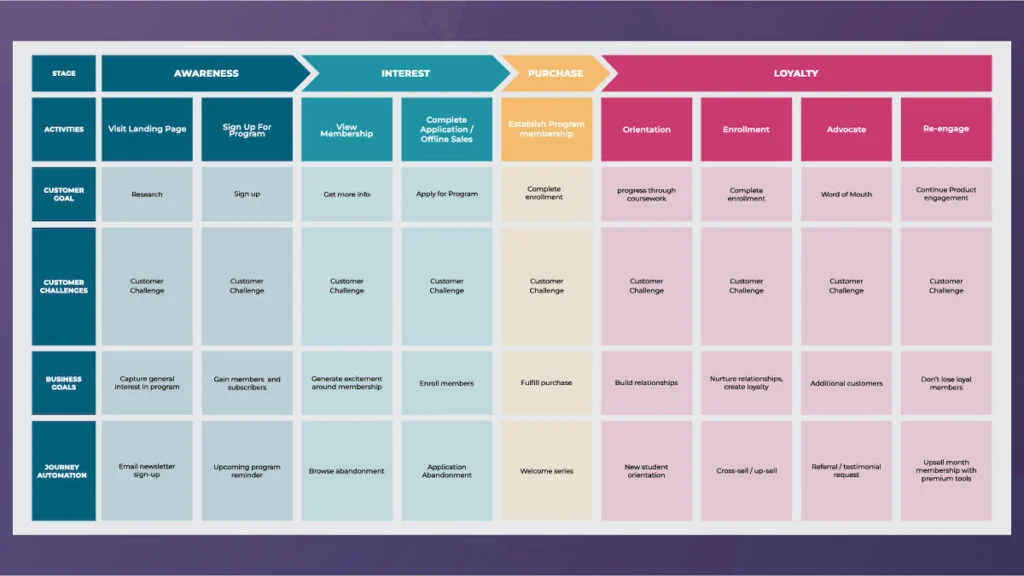What Is A Customer Journey Map And How Is It Used In Marketing?
Customer satisfaction is one of the most important facets of business success. In fact, research shows that 93% of customers are likely to make repeat purchases with companies that offer great customer service.
But to satisfy the customer, you first have to know their wants and needs. This is where a customer journey map comes in. Customer journey mapping allows you to look at your organization through the lens of your ideal customer. By taking such a perspective, you become better suited to create custom experiences and products that meet your customers’ needs.

What Is A Customer Journey Map And Why Is It Important?
The origins of customer journey mapping can be traced back to 1981 when Jan Carlzon was appointed CEO of Scandinavian Airlines. As he was working to improve operations, he noticed that the bureaucracy within the organization was hampering many internal processes.
To solve this problem, Jan developed a format that would empower customer-facing employees to make decisions quickly. He devised a framework known as moment mapping, a method used to identify the stages of the customer’s buying process. This framework helped the airline anticipate customer needs and improve their experience by providing the right offering at each moment.
The moment mapping framework has evolved since then to create more complex tools such as the customer journey map.
Starting Your Journey: The 4 Layers
A customer journey map is like the visual storytelling of a customer’s relationship and interaction with an organization. These four layers offer a starting point for creating a customer journey map.
The Journey Continues
These four layers offer a starting point for creating a customer journey map. Adding additional layers can extend This base version into more complex versions.
For example, a service blueprint can be created by adding two components to the customer journey map – an on-stage component and a backstage component.
TThe on-stage component contains all the layers that describe the actors delivering the service to the customer. The term “actor” describes anything/anyone that interacts with the customer, such as a website or employee.
An example of a layer that falls under the on-stage component is touchpoints. A touchpoint is any point of contact between an organization and its customers or potential customers. Touchpoints are important because the organization controls them and can use them to influence the customer experience directly.
The backstage component includes everything that happens behind the scenes to deliver a product or service to the customer. These are the activities the customer doesn’t see. This is why layers in the backstage component are described as “below-the-line visibility” while the layers in the on-stage component are described as “above-the-line visibility.”
Examples of layers in the backstage component include internal processes, IT systems, supply chain, etc.
The power of a customer journey map lies in its ability to drive customer-centric transformation and innovation by giving an “outside-looking-in” view into the organization.
One of the most powerful benefits of adopting the customer’s point-of-view is that it helps you craft personalized experiences. 52% of customers now expect personalized offers. Customer journey maps help to meet this demand by allowing you to hone in on the needs, experiences and behaviors of different personas in different stages of interaction with your company.
It’s important to remember, however, that customer journey mapping is not a stand-alone framework. It’s part of a larger ecosystem of tools and techniques used to improve a business’s internal processes and service delivery. These include service blueprinting, UX design, design thinking, etc.
What Makes A Good Customer Journey Map?
Customer journey mapping, like any other business process, has its own best practices. A good customer journey map is:
Draft a Customer Journey Map: 6 Steps
The Benefits Of A Customer Journey Map
Customer journey maps improve customer experience by giving you a deep understanding of your customer’s behavior. Better customer experience means happier customers ready to promote your brand to others. In fact, companies that do customer journey mapping successfully enjoy 24% more positive social media mentions and 3.5 times greater revenue from customer referrals. Here are some of the other benefits of having a customer journey map:
 ?
?
